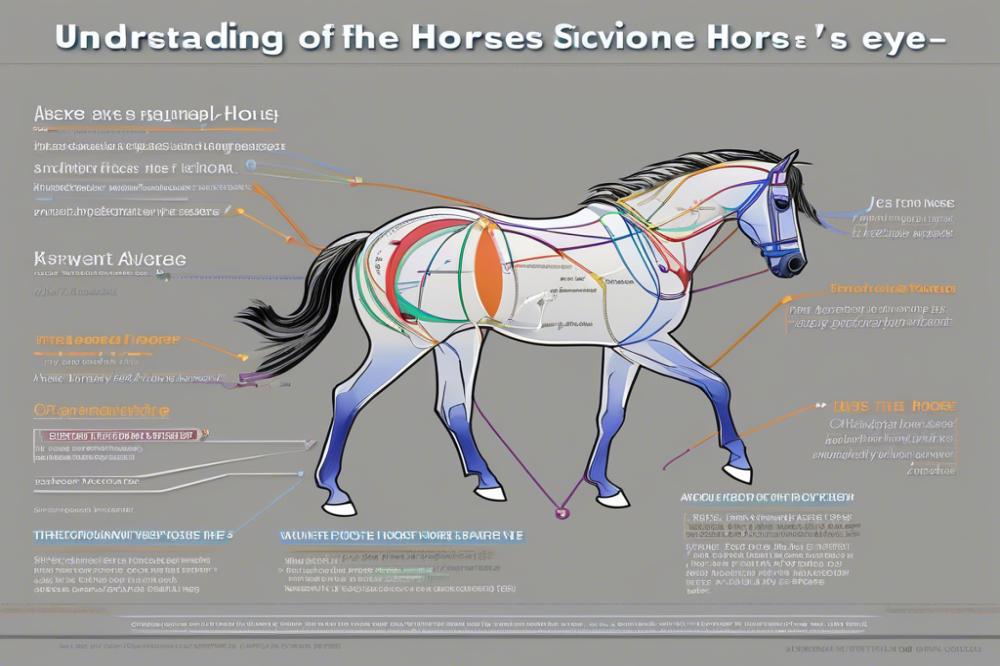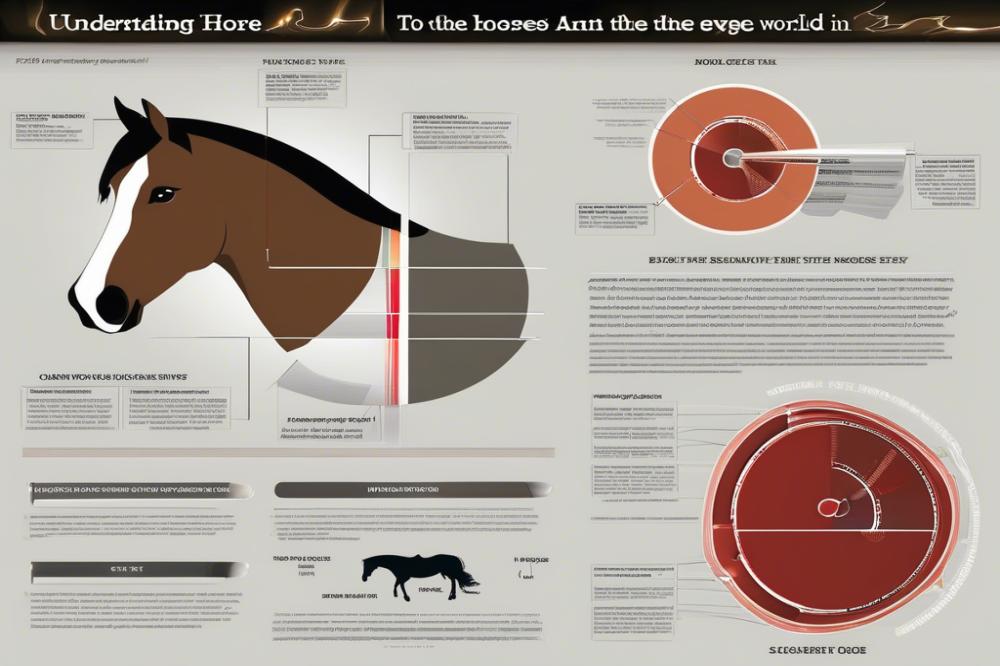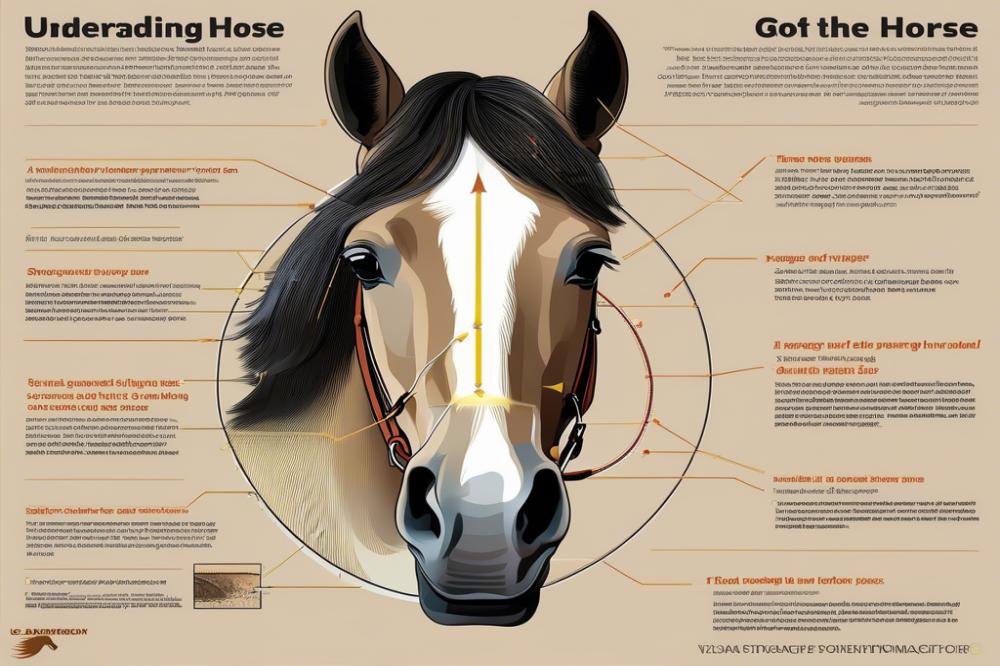Understanding horse vision
Embarking on the journey to comprehend the wonders of equine perception unveils a world remarkably different from our own. Horses, with their fascinating evolutionary background, experience their environment through a distinct lens. Their ability to observe the surroundings is shaped by a variety of anatomical features, transforming mere sight into a complex interaction with the landscape. Most notably, horse vision grants them a panoramic view, allowing these majestic creatures to detect movements with remarkable acuity.
This eyesight stems from their eye structure, which is prevalent among prey animals. The placement of their eyes on the sides of their head offers them an extensive field of vision, nearly encompassing 350 degrees. While this arrangement provides excellent awareness of potential threats, it does come with certain drawbacks, such as limited depth perception. Much like an artist who can see a landscape vividly but struggles to judge distances, horses may find it challenging to assess the space between themselves and an object directly in front.
The nature of their color perception adds another layer to their interaction with the world. While humans can perceive a vibrant spectrum, equines see a more muted palette. They are largely dichromats, indicating a vision range that differentiates between blue and yellow hues. Reds and greens appear more as shades of gray. In this context, a field bursting with a rainbow of wildflowers may look like a sea of indistinct tones to a horse, sometimes rendering it a mystery rather than a marvel.
When considering the implications of horse vision, it becomes essential to recognize how equine eyesight influences their behavior and training. Trainers and handlers often have to adapt their techniques, being mindful of how horses perceive cues and obstacles. Understanding these visual limitations can foster better communication between horse and rider. Such adjustments can enhance the harmony of partnership, facilitating a stronger bond based on empathy rather than misunderstanding.
In examining the connection between a horse’s sight and its overall well-being, appreciating the subtleties involved in their perception proves vital. The nuances of light, shadow, and movement govern their reactions and instincts. The world through their eyes may be less colorful but is undoubtedly rich with information. Whether cantering in the open field or navigating complex obstacles, horses remain attuned not merely to their immediate surroundings but also to the emotional undertones conveyed by their handlers.
This insight into how horses perceive their world does not only enlighten us about their biology; it serves to deepen our appreciation for their place in human life. The more we understand the landscape of a horse’s vision, the better equipped we are to meet their needs. Engaging with this knowledge allows us to foster enriched environments where horses feel safe, secure, and understood.
For a more detailed exploration of horse vision, visit this link. To learn more about how equine eyesight affects their interactions with stress, check out this resource.
Horse Vision

Understanding Horse Vision and how horses see the World
When contemplating how horses perceive their surroundings, it’s crucial to examine their eye anatomy. Equine eyes are large and positioned on the sides of their heads. This placement allows horses to have a broad field of view, nearly 350 degrees. They can see behind themselves without turning their heads. However, their depth perception is a bit lacking, especially directly in front. It’s as if they have panoramic sunglasses on—a great view, but less clarity for things that are closer.
Their pupils are distinct, shaped like a horizontal rectangle rather than the round variety found in humans. This feature enables horses to take in more light, especially in low-light conditions. Just imagine, while you may welcome the soft glow of dawn with your round pupils, horses embrace a brighter experience, revealing shadows where our vision might falter. Such adaptations make them excellent at spotting predators. After all, staying safe in a pasture is the name of the game.
Contrast this with human eyesight, which is notably different. Our eyes are more versatile, allowing for better depth perception and color recognition. Humans can see a spectrum of colors, while horses predominantly perceive blues and yellows. Picture yourself in a field of vibrant flowers, while a horse may perceive a more muted palette, missing out on a few colors. Yet, some studies suggest horses see better in the dark, a handy trait during dusk when many a dinner-time romp occurs.
Where humans often rely on strength in depth perception, horses utilize their wide field of view to monitor their surroundings. If they could speak, one might imagine a horse saying, “I can see you sneaking up from the left!” while focusing on the grass in front. Their visual focus shifts rapidly, making them adept at detecting movement. This need becomes apparent for survival, especially when dealing with the unpredictable nature of the wilderness.
Light sensitivity is another key point. If you’re planning on a sunny day ride, keep in mind that a sunny afternoon may challenge a horse’s vision. Sudden changes in brightness can lead to confusion, much like an unexpected bright light can disorient us. Horses typically adapt, but it’s always good to consider their perspective when planning outdoor activities.
The relationship between human and equine vision emphasizes how different species adapt to their environments. Both have advantages, shaped by their evolutionary history. In essence, horses experience the world through a lens greatly distinct from our own. Understanding the nuances of their sight fosters better communication and care. So next time you’re gallivanting with a horse, remember to think about how they are seeing the world around them, and perhaps offer them a little extra grace on that murky trail.
Field of Vision and Binocular Vision

Understanding the field of vision in equines reveals intriguing insights into how they perceive their surroundings. Horses have a broad range of eyesight, encompassing nearly 350 degrees. This impressive width allows them to detect potential threats from various angles. However, binocular vision, which is essential for depth perception, occupies a mere 60 degrees in front of them. This means that while they can scan the horizon for danger, discerning the distance and size of objects ahead requires more focus.
When observing an approaching rider or another horse, they rely heavily on this forward-facing sight. Good depth perception aids in judging jump heights and distance as they navigate varied terrains. Yet, with this ability comes a limitation. The small binocular zone, often referred to as their ‘working zone,’ can lead to confusion. For instance, a horse charging towards a jump may misjudge the obstacle’s height if distance calculations are off.
Notably, horses experience significant blind spots. These areas exist directly behind them and directly in front of their noses. If a stablemate sneaks up from behind, the horse may not notice until it is very close. This blind spot can influence behavior, especially when being approached. Sudden movements from behind might startle them, creating a sense of vulnerability. It’s akin to someone sneaking up on you while you’re engrossed in a captivating book—you simply don’t see it coming.
Moreover, the implications of these blind spots extend to their training and handling. When working with horses, caregivers must be conscious of these limitations. Approaching from the side, where the horse can see you, is often advisable. Understanding these nuances helps build trust between equines and humans, which is vital for effective communication.
In essence, the way horses see the world is a blend of expansive awareness and acute depth perception, tempered by zones of obscurity. Their vision reveals a complex interplay that shapes how they interact with their environment. Those who take time to learn these attributes will find their understanding of horse behavior deepening significantly.
Color Perception and Night Vision

Horses experience the world through a lens different from ours. Their color perception hinges primarily on dichromatic vision, which allows them to distinguish between blues and yellows. This means they can see the rich blues of a clear sky or the vibrant yellows of sunlit fields. However, reds and greens tend to blend into shades of gray for them. Imagine the colors you see fading into a gentle watercolor painting—this is how a horse might view a colorful landscape.
Discriminating between various shades poses a challenge. A horse standing in a beautifully colored meadow may not perceive the vibrant reds of poppies or the fresh greens of newly sprouted grass as distinctly as a human. Instead, the landscape could appear less vivid, casting it in a softer, more muted tone. Despite this limitation, horses utilize other factors like brightness and contrast to navigate their environment effectively.
Night vision is another interesting aspect of equine sight. Horses are crepuscular, meaning they are naturally more active during dawn and dusk. Their eyes have adapted to low light conditions remarkably well. They possess a higher proportion of rod cells compared to cone cells, allowing for greater sensitivity to light. This adaptation transforms dimly lit environments into a more navigable terrain.
Their large eyes enhance this capability, allowing more light to enter and improving their ability to see in the dark. When the sun sinks below the horizon, a horse can perceive movements and outlines, much like a nocturnal animal. Picture a dimly lit barn filled with shadows; while it may seem almost pitch black to a human, a horse can still identify the shape of a stall or the soft sway of its companion nearby.
Interestingly enough, horses also have a reflective layer behind their retinas called the tapetum lucidum. This layer bounces light back through the retina, further enhancing their ability to see in low light. It’s a natural flashlight of sorts, a built-in advantage that helps them evade potential predators that might move under the cloak of darkness.
Understanding how horses see can deepen our connection with them. Engaging with their perspective may enhance training and care practices. By recognizing that they see a world filled with muted colors and enhanced twilight visions, we can adjust our approaches accordingly, fostering better communication and a more harmonious relationship with these majestic creatures.
The Role of Vision in Horse Behavior
A horse’s visual perception plays a significant role in its daily interactions and overall behavior. Horses inhabit an environment filled with potential threats and new experiences. Therefore, how they see the world directly influences their reactions. A startled horse might leap back at the sight of a sudden movement or unfamiliar object.
Understanding how horses perceive their surroundings can bridge communication gaps between humans and these majestic animals. In training scenarios, recognizing a horse’s visual triggers can lead to more effective handling methods. For instance, taking note of a horse’s sensitivity to shadows or swift movements allows a trainer to adapt their approach. This, in turn, fosters a trustful bond where learning becomes a shared experience.
Outdoor environments significantly impact a horse’s sensory perception. Light conditions change throughout the day, and horses experience varying degrees of visibility. A dimly lit barn can cause horses to perceive their surroundings as threatening. Also, the presence of obstacles such as fences and trees alters a horse’s movement and behavior. These distractions can provoke anxiety, affecting how they react to training commands.
Moreover, a horse’s vision affects herd dynamics. Horses communicate through body language, and how an individual perceives the movements of others can shape their response. They rely heavily on visual cues from their companions. A twitch of an ear or the flaring of nostrils can indicate changes in mood or urgency. Such nuances, understood through visual perception, enhance social cohesion within the herd.
Seasonal changes also play a part. Bright sunlight in summer may cause horses to squint, affecting their ability to spot hazards. Conversely, during winter months, the phenomenon of snow can reflect glaring sunlight, further complicating their vision. This unpredictability in environmental factors underscores the necessity for horse handlers to remain aware of context and adjust their methods accordingly.
Working with a horse requires an appreciation of how it interprets visual stimuli. The understanding of a horse’s perspective reveals new depths in training techniques. Exercises that involve desensitization to strange objects harness this knowledge. Trainers can expose horses gradually to various sights, slowly building their confidence. Hence, recognizing some horses may be more visually impulsive than others can make a world of difference in approach.
Every interaction with horses becomes an opportunity to foster a deeper understanding of their behavior. So, next time you approach a horse, consider its unique perception. What appears benign to you might look like a monstrous creature to them. Learning to read these signals will enhance not only your riding or training experience but also the relationship you cultivate with your equine friend.
Final Thoughts on Equine Perception
Understanding how these magnificent creatures perceive their surroundings offers a fascinating glimpse into their world. The remarkable structure of their eyes, paired with the intricacies of their brain, facilitates an awareness that is both broad and nuanced. Colors remain less vivid to them than to humans, yet their ability to detect movement and shadows outpaces our own.
Shadows dance and shapes shift in subtle ways, guiding their responses to potential threats. This reality underscores the importance of creating a tranquil environment for them. Observing how they navigate their spaces can offer invaluable insights into their comfort and emotional state. Each moment spent observing a horse can be a profound reminder of their sensitivity.
During interactions, humans can bridge the gap between species by being mindful of these perceptions. Not every moment shared is marked by clarity. A sudden movement might spook a horse, while a calm demeanor could foster trust. Navigating this relationship requires patience and understanding.
In exploring the complexities of how these animals engage with their environment, one begins to appreciate their instincts. The unique visual adaptations they possess play a significant role in their survival. Embracing this knowledge not only enriches the owner and equestrian experience but also deepens our connection to them. For those eager to learn more about the structure and function of horse eyes, visiting resources about horse eye anatomy can be enlightening.
Curiosity can lead to enriching experiences. For anyone fascinated by these majestic beings and the way they comprehend the world, a deeper investigation is warranted. This understanding allows for better care, training, and interaction. Keep exploring and stay engaged with your passion.
To enhance your knowledge, don’t hesitate to take the next step. Sign up for our service today to connect with an innovative community dedicated to furthering your equine journey: Join now. For an even broader perspective, the article on how horses see is a must-read for any enthusiast.



